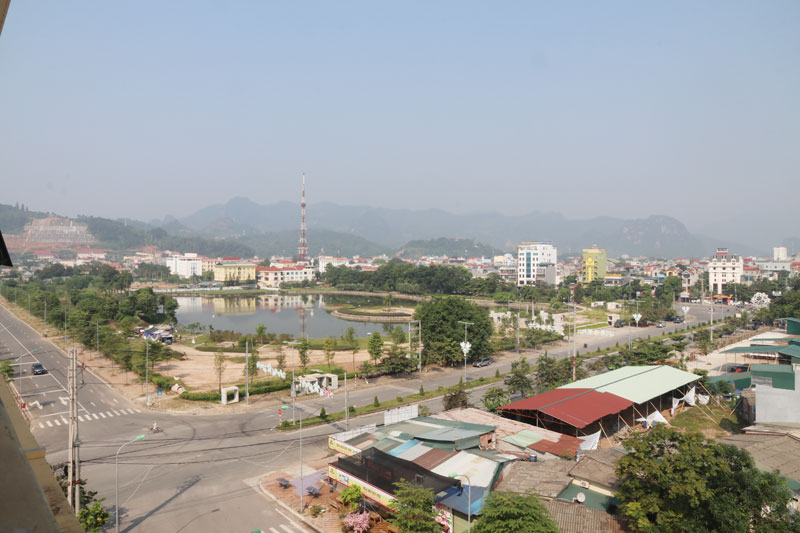
(HBO) - According to the provincial Department of Taxation, the State budget collection in the first two months was estimated at 420 billion VND, reaching 10 percent of the estimate assigned by the government and 9 percent of the target set in the provincial People’s Council’s resolution, and equal to 96 percent of the collection in the same period last year.
 The increase in
State budget collection helps promote socio-economic development. Photo:
A corner of Hoa Binh city.
The increase in
State budget collection helps promote socio-economic development. Photo:
A corner of Hoa Binh city.
Revenues from taxes and fees (excluding land use
fees) hit 350 billion VND (13 percent of assigned target, 12 percent of
provincial target and 84 percent of the figure for the same period last year).
Land use fees totaled 70 billion VND (5 percent of assigned target, 4 percent
of provincial target and 363 percent of the figure of the same period last
year).
Notably, 11 out of the 17 State budget revenue
sources showed increases this year, including land use fees (263 percent),
fixed revenues in communes (86 percent), fees from granting rights to mineral
exploitation (59 percent), non-agricultural land use tax (31 percent), lottery
(24 percent), personal income tax (11 percent), and environmental protection
tax (17 percent). Tax collection from local State-run businesses was up 100
percent.
The taxation department will propose measures to
the provincial People’s Committee on reforming mechanisms, policies and administrative
procedures to encourage and attract investment, develop business production,
promote economic growth, thus creating more revenue sources for the State
budget.
It will coordinate measures to implement more
effectively policies of the government and provincial People’s Committee on
stabilizing macro economy, increase support for businesses, promptly remove
their difficulties, and facilitate business and production activities.
The department will step up measures to prevent budget
collection loss, contributing to curbing inflation, maintaining macroeconomic
stability and ensuring social welfare. It will also push ahead with the
modernization of tax management alongside with administrative procedure reform.
In March, the taxation sector aims to collect
350 billion VND for the local State budget to increase the three-month revenue
to 770 billion VND, meeting 18 percent of assigned target, 16 percent of
provincial target and a year-on-year rise of 6 percent, according to Nguyen Anh
Tuan from the Taxation Department./.
According to data from the Hoa Binh Provincial Party Committee, the industrial production index for the first six months of 2025 is estimated to have increased by 20% compared to the same period last year. This marks the highest year-on-year growth rate for this period since 2020.
In the first six months of 2025, Hoa Binh province’s export turnover was estimated at 1.145 billion USD, marking an 18.11% increase compared to the same period in 2024. Import turnover was estimated at $ 804 million, a 17.15% increase, which helped the province maintain a positive trade balance.
The lives of the ethnic minority farmers in Tan Lac district have gradually improved thanks to the new directions in agricultural production. This is a testament to the collective strength fostered through the professional associations and groups implemented by various levels of the district’s Farmers’ Union.
With the motto the "product quality comes first,” after nearly one year of establishment and operation, Muong village’s Clean Food Agricultural and Commercial Cooperative, located in Cau Hamlet, Hung Son Commune (Kim Boi district), has launched reputable, high-quality agricultural products to the market that are well-received by consumers. The products such as Muong village’s pork sausage, salt-cured chicken, and salt-cured pork hocks have gradually carved out a place in the market and they are on the path to obtaining the OCOP certification.
In the past, the phrase "bumper harvest, rock-bottom prices" was a familiar refrain for Vietnamese farmers engaged in fragmented, small-scale agriculture. But today, a new spirit is emerging across rural areas of Hoa Binh province - one of collaboration, organisation, and collective economic models that provide a stable foundation for production.
Maintaining growing area codes and packing facility codes in accordance with regulations is a mandatory requirement for agricultural products to be eligible for export. Recently, the Department of Agriculture and Environment of Hoa Binh province has intensified technical supervision of designated farming areas and packing facilities to safeguard the "green passport" that enables its products to access international markets.



 The increase in
State budget collection helps promote socio-economic development. Photo:
A corner of Hoa Binh city.
The increase in
State budget collection helps promote socio-economic development. Photo:
A corner of Hoa Binh city.